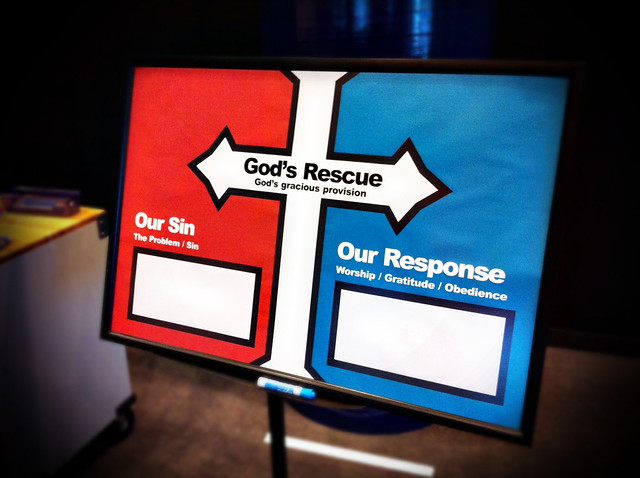In addition to a filtered pass where we look as individuals for unhelpful emphases on law without context to grace, and a filtered pathway through which all curricula under consideration passes, Clear Creek Community Church also employs a filtered point.
One of the resources that helped tutor CCCC’s teaching into a better gospel-centered framework is Dr. Bryan Chapell’s wonderful book Christ-Centered Preaching. I had the opportunity to briefly study under Dr. Chapell while getting my doctorate at Covenant Seminary. His strategy to help move preachers and teachers toward gospel-centrality is the most accessible approach I’ve seen. I like it so much I’ve sought to employ its principles not only for our adult worship service preachers but all age-graded ministries teaching.
One of Dr. Chapell’s main ideas is that redemptive teaching sees a progression in biblical interpretation which moves from OUR PROBLEM to GOD’S PROVISION for that problem to OUR RESPONSE to his provision. In other words, we see a three step process:
- Our Sin
- God’s Rescue
- Our Response
The order is incredibly important. Far too often it seems that Sunday lessons in a children’s ministry may leave the impression that our sin (the problem) is remedied by better behavior (our response) in order for God to give us grace (his rescue). As a result, lessons revolve heavily on behavior modification instead of the provision of grace God provides in Jesus. In the end, kids walk away with Sesame Street sprinkled with Jesus dust hoping that they’ll be good enough for God instead of hearing the life changing truths of the gospel.

That’s why the children’s ministry at CCCC designed what they call their “gospel frame.” It is a board on which you can draw with a dry erase marker. At the end of every lesson, the teacher for the day walks through each phase (our sin-God’s gracious rescue-our response to God’s gracious rescue), writing down how the particular lesson fits into each phase, in the hopes that gospel truth is further crystallized in the hearts and minds of the children. Once the service is over, they simply clean the board and it’s ready for next week.
This activity accomplishes several different things:
- It provides some security each week for gospel-centrality.
- It allows us to open up the bandwidth to the amount of curriculum we can use.
- It teaches our children a way to see the gospel in their own reading of the Bible.
- It provides a framework for our adult leaders to how they should read their Bibles.
As one can see, utilizing this filtered point helps ensure that instead of revolving around good habits or sound morals each weekend, we leave our kids with the one thing (or point) they might likely not get anywhere else – the gospel of Jesus Christ.
Next post will look at the fourth step in CCCC’s filtered process.
